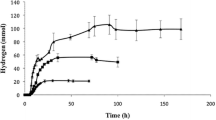Summary
Production of acetate, the key substrate for methane formation in anaerobic digesters, is limiting in cattle waste-fed biogas digesters due to the lignocellulosic nature of the substrate. Since the rate of cellulose hydrolysis affects acetate production, and the number and type of cellulolytic bacteria that exist in a cattle waste biogas digester is not known, 110 cellulolytic bacterial isolates belonging to the Bacillaceae, Propionibacteriaceae and Lactobacillaceae, and coryneform bacteria likeCellulomonas, were isolated from different depths of an operating 103 KVIC type biogas digester. The population of cellulolytic bacteria varied between 2.0×103 and 1.4×105/g slurry. Some bacterial isolates exhibited higher cellulase activity than others, with acetate as the major end-product. In general, acetate, propionate and butyrate were the common end-products but one isolate was homoacetogenic and a few others produced propionate or butyrate orisobutyrate in small amounts with acetate. Cellulose degradation rate in the digester was dependent upon the cellulose: lignin ratio.
Résumé
Dans les digesteurs anaérobies produisant du biogaz à partir de fumier de bovins, la production d'acétate, qui est l'étape essentielle conduisant au méthane, est limitée à cause de la nature ligno-cellulosique de la matière première. Il a été procédé à des prelévements à différentes profondeurs dans un digesteur KVIC en service, et à 110 isolements de bactéries cellulolytiques appartenant aux Bacillaceae, Propionibacteriaceae, Lactobacillaceae et bactéries coryneformes du typeCellulomonas. Les populations de bactéries cellulolytiques dénombrées varient entre 2,0×103 et 1,4×105 par g. d'échantillon. Certaines des bactéries isolées ont une activité cellulase plus élevée que d'autres, et dans tous les cas l'acétate est le produit prédominant. D'une manière générale, l'acétate, le propionate et le butyrate constituent les produits principaux. Une souche est homo-acétogène. Un petit nombre d'autres produisent, en dehors de l'acétate, de faibles quantités de propionate, de butyrate et d'isobutyrate. La vitesse de dégradation de la cellulose dans le digesteur dépend du rapport cellulose/lignine.
Resumen
La producción de acetato, substancia clave para la formación de metano en digestores anaerobios, es el factor limitante en las plantas de biogás, alimentadas mediante residuos de ganado, debido a la naturaleza lignocelulósica del material de partida. La velocidad de hidrolisis de la celulosa afecta a la producción de acetato, sin embargo, nose conocen ni el tipo ni la cantidad de bacterias que existen en una planta de biogas de dichas características. Se aislaron 110 cepas bacterianas con propiedades celulolíticas que pertenecían a los grupos de Bacillus, Propionibacterias, y coryneformes, (como el géneroCellulomonas). Estudiando la población de bacterias celulolíticas a distintas profundidades de un digestor de biogás del tipo 103 KVIC, se observó que ésta variaba entre 2.103 y 1.4 103 celulas/g de residuo liquido analizado. Algunos de los aislados bacterianos mostraron una mayor actividad celulolitica que otros, siendo el acetato el producto final mayoritario. En general los productos finales más corrientes fueron: acetato, butirato y propionato; sin embargo, una de las cepas aisladas era homoacetogénica y algunas otras produjeron pequeñas cantidades de propionato, butirato oisibutirato junto con acetato. La velocidad de degradación de la celulosa dependía de la relación celulosa: lignina.
Similar content being viewed by others
References
Braun M., Schoberth, S., &Gottschalk, G. 1979 Enumeration of bacteria forming acetate from H2 and CO2 in anaerobic habitat.Archives of Microbiology 120, 201–204.
Carlsson, J. 1973 Simplified gas chromatographic procedure, identification of bacterial metabolic products.Applied Microbiology 25, 287–289.
Crampton, E. W. &Maynard, L. A. 1938 The relation of lignin and cellulose content to the nutritive value of animal feed.Journal of Nutrition 15, 383–395.
Halliwell, G. 1973 Microbial β-glucanases.Progress in Industrial Microbiology 15, 1–60.
Hobson P. N. 1974 Fundamental microbiological aspects of waste treatment (Abstract).Journal of Applied Chemistry and Biotechnology 24, 375.
Jain, M. K., Singh, R. &Tauro, P. 1981 Anaerobic digestion of cattle and sheep wastes.Agricultural Wastes 3, 65–73.
Jain, M. K., Singh, R. &Tauro, P 1981 Diurnal variations in gas production from biogas Khadi Gram Udyog27, 314–315.
Jain, M. K., Singh, R. &Tauro, P. 1983 Cattle waste anaerobic digestion in a semicontinuous and a batch digestor.Agricultural Wastes 7, 251–259.
Kotze, J. P., Thiel, P. G., Torien, D. F., Hattingh, W. H. J. &Siebert, M. L. 1968 A biological and chemical study of several anaerobic digestors.Water Research 2, 195–213.
Maki, L. R. 1954 Experiments on microbiology of cellulose decomposition in a municipal sewage treatment plant.Antonie Van Leeuwenhoek 20, 185–200.
Mandel, M., Andreotti, R. &Roche, C. 1976 Measurement of saccharifying cellulases.Biotechnology and Bioengineering Symposium 6, 21–23.
Mountfort, D. O. &Asher, R. A. 1978 Changes in proportions of acetate and carbon dioxide used as methane precursors during anaerobic digestion of bovine waste.Applied and Environmental Microbiology 35, 648–654.
Mann, S. O. 1968 Rumen bacteria. InMethods in Microbiology Vol. 3B. ed. Norris, J. R. & Ribbons, D. W. p. 140. London and New York: Academic Press.
Nelson, N. 1944 A photometric adaptation of Somogyi method for the determination of glucose.Journal of Biological Chemistry 153, 375–380.
Saddler, J. M. &Khan, A. W. 1980 Cellulase production byAcetovibrio cellulolytica.Canadian Journal of Microbiology 26, 760–765.
Singh, R., Jain, M. K. &Tauro, P. 1980 Acetate assimilation and production of methane by cattle waste slurry.Current Science 49, 399–400.
Singh, R., Jain, M. K. &Tauro, P. 1981 Press mud as additive to increase biogas production from cattle waste.Current Science 50, 640–643.
Singh, R., Jain, M. K. &Tauro, P. 1982 Rate of anaerobic digestion of cattle waste.Agricultural Wastes 4, 267–272.
Singh, R., Jain, M. K. &Tauro, P. 1983 Predigestion to improve production of biogas from cattle waste.Agricultural Wastes 6, 167–174.
Singh, R., Malik, R. K., Jain, M. K. &Tauro, P. 1984 Biogas production at different solid concentration in daily fed cattle waste digestor.Agricultural Wastes 11, 253–257.
Zeikus, J. G. 1980 Microbial populations in digestors. InAnaerobic Digestion ed. Stafford, D. A., Wheatley, B. I. & Hughes, D. E. pp. 61–89. London: Applied Sciences Publishers.
Author information
Authors and Affiliations
Rights and permissions
About this article
Cite this article
Singh, P.R., Jain, M.K. Studies on the cellulolytic bacteria and cellulose degradation in a cattle waste-fed biogas digester. Mircen Journal 2, 309–317 (1986). https://doi.org/10.1007/BF00933497
Received:
Accepted:
Issue Date:
DOI: https://doi.org/10.1007/BF00933497




